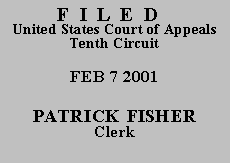 UNITED STATES COURT OF APPEALS
UNITED STATES COURT OF APPEALS
 UNITED STATES COURT OF APPEALS
UNITED STATES COURT OF APPEALS
TENTH CIRCUIT
| UNITED STATES OF AMERICA, | |
| v. | No. 00-4085 |
| KIMBERLY ANN TYROLT, | (D.C. No. 00-CR-37-B)
(D. Utah) |
ORDER AND JUDGMENT(*)
Before HENRY, BALDOCK, and LUCERO, Circuit Judges.(2)
In November 1996, Defendant pled guilty to false representation of a social security number in violation of 42 U.S.C. § 408(a)(7)(B). The district court sentenced Defendant to eighteen months imprisonment followed by thirty-six months of supervised release. In April 2000, Defendant admitted six violations of the terms and conditions of his supervised release. The district court revoked Defendant's current term of supervised release and sentenced her to eighteen months imprisonment followed by eighteen months supervised release. Defendant appeals her sentence. We exercise jurisdiction pursuant to 28 U.S.C. § 1291 and 18 U.S.C. § 3742, and affirm.
Under 18 U.S.C. § 3583(e)(3), upon revocation of supervised release, the maximum term of imprisonment is two years where the original offense was a Class D felony. Where the original offense was a Class E felony, however, the maximum term of imprisonment upon revocation of supervised release is one year. The district court determined Defendant's original § 408 offense was a Class D felony and sentenced Defendant accordingly. 18 U.S.C. § 3559(a)(4) classifies a Class D felony as a felony with a maximum term of imprisonment of "less than ten years but five or more years." A Class E felony, on the other hand, carries a maximum term of "less than five years but more than one year." Id. § 3559(a)(5).(1)
Defendant's original offense under 42 U.S.C. § 408(a)(7)(B) carried a statutory maximum term of imprisonment of "not more than five years."
Defendant argues the original § 408 offense was a Class E felony. Specifically, Defendant argues the phrase "not more than five years" means four years and 364 days. Contrary to Defendant's argument, the plain language of § 408(a)(7)(B), "not more than five years," clearly includes a maximum term of imprisonment of exactly five years. Therefore, Defendant's § 408 conviction is a Class D felony. Defendant concedes that if we determine the original offense is a Class D felony, the district court properly sentenced Defendant under 18 U.S.C. § 3583(e)(3) and (h). We agree. Accordingly, Defendant's sentence is
AFFIRMED.
Entered for the Court,
Bobby R. Baldock
Circuit Judge
*. This order and judgment is not binding precedent, except under the doctrines of law of the case, res judicata, and collateral estoppel. The court generally disfavors the citation of orders and judgments; nevertheless, an order and judgment may be cited under the terms and conditions of 10th Cir. R. 36.3.
2. After examining the briefs and appellate record, this panel has determined unanimously to honor the parties' request for a decision on the briefs without oral argument. See Fed. R. App. P. 34(f); 10th Cir. R. 34.1(A)(2). The case is therefore ordered submitted without oral argument.
1. 18 U.S.C. § 3559(a) provides in relevant part:
"[a]n offense that is not specifically classified by a letter grade in the section defining it, is classified if the maximum term of imprisonment authorized is
(4) less than ten years but five or more years, as a Class D felony;
(5) less than five years but more than one year, as a Class E felony."